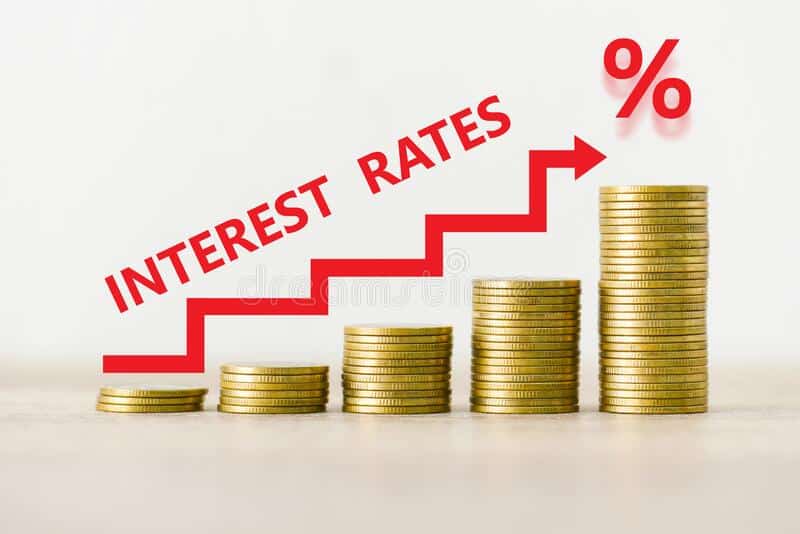Changes in interest rates set by the Central Bank can have an effect on the value of your bond. Today, we will be discussing interest rate risks on your bond investment.
What is interest rate risk?
When we talk about interest rate risk, we are referring to the fact that interest rates can change depending on the Monetary Policy implemented by the government. The organization responsible for implementing monetary policies in any country is the Central Bank. For Zambia, it is the Bank of Zambia. Therefore, when the Bank of Zambia reveals its base lending rate or BOZ (Bank of Zambia) policy rate, it can affect the cost of goods and services on the market, including the value of your investment in the bond.
If you have invested in a government bond and do not intend to sell it until the bond matures, you may not be exposed to interest rate risk. This is because, at maturity, you will receive the full face value amount and bi-annual coupon income. Therefore, you are protected from this risk of interest rate changes because you are holding onto the bond until maturity.
However, if you intend to sell your bond on the secondary market, such as the Lusaka Securities Exchange in Zambia, you need to keep a close eye on the interest rate because changes in the interest rate can affect the price of the bond you have invested in. It is important to note that sometimes, you may want to sell your bond ahead of its maturity, for instance, if you need money for an emergency or other urgent needs. Alternatively, as an informed investor, you may have already determined that this investment in the bond is not giving you the desired return on investment. In this case, you may want to consider other investment options, and selling your bond on the secondary market is a viable option.
To reclaim your cash back before the maturity date, you may choose to sell your investment in a bond on the secondary market. This is one of the reasons why investors dispose of their investments in bonds on the secondary market. If you intend to sell your investment in a bond on the secondary market, you need to be aware of the risk of interest rates on your investment in that bond.
Let’s return to the previous example to understand the interest rate risk on your bond investment
- The base lending rate, which can be affected by various factors such as inflation, economic performance, and the direction the government wants to take the economy
- When the base lending rate in a country is revised upwards, we can expect that the cost of goods and services will generally go up.
- If the interest rate is increased upward, borrowing from a commercial bank may also go up, automatically. The same risk applies to your investment in the bond.
Interest rate risk from a corporate bond perspective.
Assuming you have invested in a corporate bond, which is a bond that a company issues, instead of a government bond, the issuer is a corporate or a company. If you have bought a corporate bond and the interest rates go up, maybe you invested in a corporate bond with a 10% interest rate, and then the central bank revises it upwards, maybe by a percentage such that all the interest rates in the market have gone up. You are still holding on to this corporate bond, which is valued at a 10% interest rate. What will happen to the new bonds that this company is going to issue?
It is very unlikely that they will be issued at 10%. What is likely to happen is that the new corporate bonds are going to be issued at a higher interest rate, meaning that your bond has lost value. In other words, the price for your bond will have to come down to match the return on that investment on the bond that you have made. Because the lending rate has gone up, it will result in the price of your bond also coming down. No one wants to buy your bond at the current price or the price that you bought it for. For you to even stand a chance of selling that bond, you will have to reduce the price. That is the effect of changes in interest rates on bonds.
Now, for us to understand the effect of interest rates on the Zambian government bonds, we must look at the results of the bonds. I took a look at the results for the bonds over different years, 2016, 2019, and 2022. In fact, in 2022, I looked at two months, March 2022 and August 2022.
When you look at the results for the bond for March 2022, you notice that the cut-off yield rate was 22.25% and the cut-off price was ZMW67.04. The coupon rate was 11%. If you go to August 2022, results for the same five-year bond, you are going to find that the cut-off yield rate is 24%. It went up in August, resulting in the drop of the bid price or price of the bond to ZMW65.5126. The coupon rate remains the same.
What I get from this is that when the yield rates are going up, the price is coming down. The price of the bond is coming down. Inversely, we can say that when the yield rate is coming down, the price of the bond should go up. Many factors affect the yield rate on a bond other than the interest rate, which we are looking at today. Inflation also affects the yield rate. The general economic performance of the country affects the yield rate in that country.
Zambia is an interesting case because when I searched for the base lending rates for Zambia for the previous few months starting from January, I noticed that the base lending rate has been constant. It’s been at nine percent for many months now. In fact, since March, the base lending rate has been at nine percent. The coupon rate for a five-year bond, has also remained unchanged. In fact, if you look at many other bonds, the coupon rate has been fixed for a five-year bond. It’s been 11% for so many years now.
If we look at how interest rates affect the bond, especially if we go back to the example that we’ve been looking at in my previous articles, we can see the effect of the change in the interest rates on the government bond. When you take a look at the previous example that we considered, I’ve included some extra rows. I’ve included the (nper) which is the number of periods for the bond. In this case, we have five years. I’m looking at the March 2022 bond as well as the August 2022 bond. The coupon rates are the same, but the cut-off prices are different. Remember, the August 2022 yield rate is more, as a result, the cut-off price is low. It’s got an inverse relationship. The March 2022 cut-off price is ZMW67.046, and the August 2022 cut-off price is ZMW65.126. The nominal price is ZMW100, and it doesn’t change. The number of periods is five.
Now, if you look at the coupon incomes, they are fixed. This is why bonds are referred to as fixed-income investments. The coupon income is fixed, it’s the same. However, the interest income is different. This is because of the price of the bond. Okay, the August bond is selling at a lower price compared to the March bond. So, we find that the interest income is higher. Naturally, because I’m buying it at a lower price, so I expect to make much more income than the March bond.
Now, if we come down here, the yield rate is more like the return on the investment of a bond. The yield rate is computed with a very simple formula, and that is yield is equal to coupon amount over price. That is the yield rate. So, if you look at the coupon amount, which is ZMW5,500, divided by the cost value amount, which is ZMW33,523, it gives you a yield rate of 16,41%. So, those are the two numbers that are making up the yield rate. It’s the coupon, it’s the annual coupon income divided by the price of the bond that gives you your yield rate.
For March 2022, the yield rate on a ZMW50,000 bond investment is 16.41%, and the yield rate for the August 2022 ZMW50,000 bond investment is 16.79%. So, the August 2022 bond investment has a higher yield compared to the March 2022 bond investment. However, very interesting is that upon maturity, of course, you get the face value back.
Now, look at the difference here. The interest income is ZMW17,000, and the cost is ZMW32,756.30 giving both bonds the same face value return. For the yield rate, which you can get as a formula in Excel, you simply need to type in “rate,” and then you put the number of periods, for example, for this March investment, the number of periods is 5, comma, the monthly payment, which is the coupon rate, comma, present value is your investment in the bond, so it’s a negative investment in the bond, which is, in our example here, 33,523. Let me pick the one up here, comma, the future value, which is how much you expect to get in return, ZMW50,000, enter gives you the yield to maturity rate. If we copy this formula across August 2022, we get the same yield to maturity.
If we go back to the definition of the interest rate risk on a bond, we’ve said that generally when interest rates go up, we expect new bonds to be issued at higher interest rates because no one is going to buy the same bond with the same interest rate or coupon rate.
Assuming that this is a corporate bond, not a government bond, what would normally happen is that when interest rates go up, the Central Bank’s base lending rate would increase to reflect the new interest rate percentage. If this new bond is issued in August, we do not expect the coupon rate to remain at 11%; instead, we expect it to go up to reflect the increase in the interest rate. Let’s assume that this new bond is issued at 12%. This will change all the metrics, but most importantly, it will change the yield rate as well as the yield to maturity rates.
If you are an investor in the March 2022 bond, your bond has lost value because the yield rate remains at 16.41% and the yield to maturity rate is 23%. To sell that bond on the secondary market, you will need to reduce the price of your bond to match what is generally happening on the market. That is the risk you face when you invest in a bond.
Now, it is strange with the Zambian government bonds because the coupon rates are fixed regardless of changes in interest rates, although the yield rates are changing. As you have seen from the March 2022 bond results compared to the August 2022 bond results on a five-year bond, the yield rates have changed, but the coupon rates have remained the same. The general concept in terms of our interest rate risk on a bond is that when the Central Bank increases the best lending rate, we expect new bonds to be issued at a higher interest rate, resulting in the bond you are currently holding losing its value. As a result, you will have to reduce the price of your bond to stand a chance of selling it on the secondary market.
Secondary market (LuSE)
When we look at our secondary market, which is the Lusaka Securities Exchange, there is very little information on the prices for bonds on the Lusaka Stock Exchange. I am pretty sure that the government is aware of this, and I hope they have plans to ensure that the secondary market is really active and we receive information on the performance of the bonds.
If you are an individual that would like to sell a bond on the secondary market in Zambia right now, the best option you have is to contact the Bank of Zambia directly or go to any Commercial Bank that trades in bonds. Many commercial banks trade more in treasury bills, and you will be able to find out a lot more information from the commercial banks as well as the Bank of Zambia in terms of what the current price for a bond is or is likely to be. I think they have much more information in terms of market data on the value of the bonds on the secondary market.
You may also contact the Lusaka Securities Exchange. Being the secondary market, they should have information on the prices of bonds.


